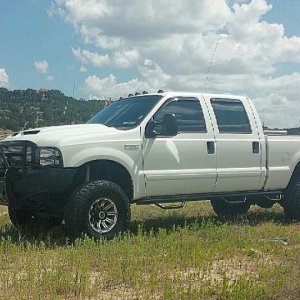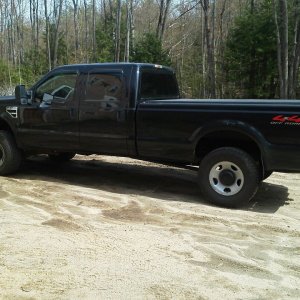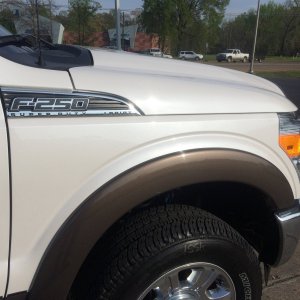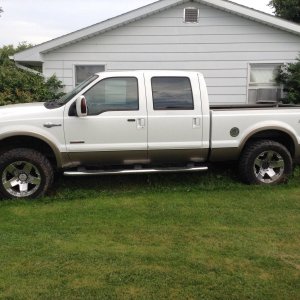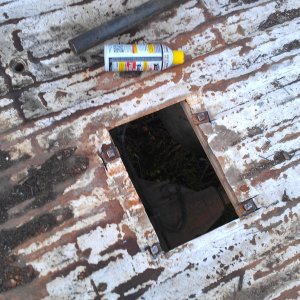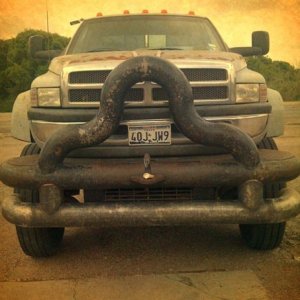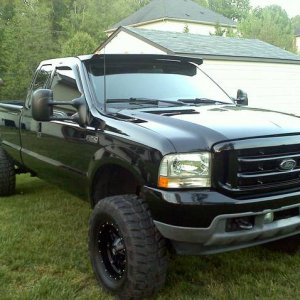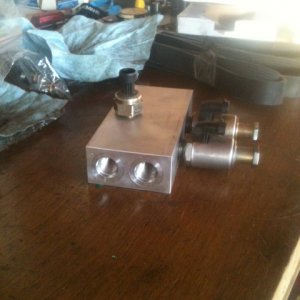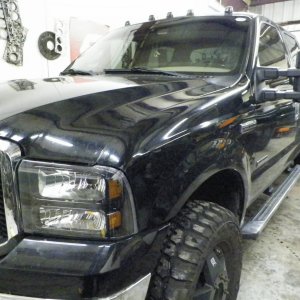Cold Roller
Member
Rich, nice shims!
So I finally got the injectors in the truck over the past 2 days. I did the ARP head-studs as well one-by-one. All I can say is that cab-off would have made this one easier. Without evacuating the AC and just pulling the HVAC box straight out, I decided to pull the exchanger, first but it wasn't playing nice and was a biatch to get out of the HVAC housing. Of course, on the install it slipped right in without much effort! Then I get a sinus block that made my head pound anytime I laid on the engine to do any work...
Two 20 second cranks and 8 seconds of power-up cranking to start it. It idled nice with just a very slight lope for 2 minutes.
So, here is a vid of the idle after driving it to work and back today (40 minutes each way).
https://www.youtube.com/watch?feature=player_detailpage&v=LwKTc7r39fU#t=0s
So here is what I did. I will be the first to admit that I made a slight measurement mistake (so I won't post what I cut to), because I didn't initially figure in how much wasted plunger bore I should have used. So after it was all said and done, I took out the spool shim to give me the chamber volume I wanted and where the plunger would sit relative to the spill port. Had I left the shim in, my chamber volume would have been about 0.215cc (215cc injector), but 35cc would have been above the spill port, and that was probably too much. My understanding is that a volume of 0.205cc will yield about 0.188cc with some loss out the spill port. I am just guessing here, but if too much goes out the spill port before the plunger covers it, it probably would not start or idle very well.
So now that I have bored you with that, this is what you do.
Turn down the intensifier piston the amount you want to increase your stroke by. If you use 0.050" that gives a stroke volume increase of 0.040cc. So your stock injectors can now move 0.175cc (175cc injector).
Of course, if you don't also reduce the plunger by some amount, your plunger would strike the fuel plate and probably destroy the injector. So now you need to cut 0.026" off the plunger to give a full stroke. However, you must ensure the plunger is not proud, so it might be a good idea to cut 0.030" off. I understand you can turn this on a lathe as well, but because of the DLC, the shop used a diamond lapping cutter. The tolerances are all to 0.0001". Look at the end of this one compared to Lilpooh's pic above.

I had my nozzles extrude honed to 75% over by Chatham Fuel Injection services in Canada. Just under $400 with shipping and taxes.
I made a holding tool as well, but out of aluminum. It must me able to hold it tight, because you need a lot of force to unscrew the body. FWIW, my injectors were all eBay purchases, 2 used, 2 Alliant remans, and 4 BWD remans. The total cost to buy them was $600 over a few weeks. The cheapest one, $56, was the prettiest of the bunch! No core charges. They all looked the same internally and measured similar tolerances. The 2 used ones had partially blocked nozzles. One Alliant has a slight blockage as well (who would have thought!). All would have worked in a stock truck without problems. This did not affect the honing, although the used ones take longer due to case hardening from engine heat.
So, for $1,200 and my time to figure it out, I got 8 injectors at 185/75.
For my slightly goofy cut, I also have the option of plugging the spill-port (3.5mm brass plug) to bring them up to 215cc. But one thing to consider about the spill-port, it is designed to let high pressure fuel bleed out before it is squeezed into the oil side of the injector.
There are other ways to increase chamber size, such as the shims above, but these 2 methods set the injectors to run very close to normal for easy starting and idle characteristics.
Another concern to keep in mind is the fuel plates themselves. It is probably necessary to increase the space available between the plates to have enough fuel to fill the larger chambers (above 190). If you didn't look closely, you might miss how small the space between back half of the fuel plates is!
Of course, you need a bigger turbo or you will just blow smoke. I crafted a 63.5/88mm wheel and housing to my powerstroke back-end. It works well, but not good enough for a large PW tune with these injectors. Temps are OK, but it will smoke a bit.
One last note, crazy fuel milage. I average almost 28mpg today compared to my typical 19mpg. I just had on the canned SCT Performance tune (if you can call it performance) to ensure it would start and run without over-fuelling issues.
This all started as a what goes into what makes the magic. It ended up with me following through to a final conclusion. If I was in the USA, I probably would have just sent the pieces to Renegade, but shipping in and out of Canada was going to be a PITA.
Look at some of my channel vids. Here is one to show plunger movement.
https://www.youtube.com/watch?feature=player_detailpage&v=GU8ERlPGiWw#t=0s
So I finally got the injectors in the truck over the past 2 days. I did the ARP head-studs as well one-by-one. All I can say is that cab-off would have made this one easier. Without evacuating the AC and just pulling the HVAC box straight out, I decided to pull the exchanger, first but it wasn't playing nice and was a biatch to get out of the HVAC housing. Of course, on the install it slipped right in without much effort! Then I get a sinus block that made my head pound anytime I laid on the engine to do any work...
Two 20 second cranks and 8 seconds of power-up cranking to start it. It idled nice with just a very slight lope for 2 minutes.
So, here is a vid of the idle after driving it to work and back today (40 minutes each way).
https://www.youtube.com/watch?feature=player_detailpage&v=LwKTc7r39fU#t=0s
So here is what I did. I will be the first to admit that I made a slight measurement mistake (so I won't post what I cut to), because I didn't initially figure in how much wasted plunger bore I should have used. So after it was all said and done, I took out the spool shim to give me the chamber volume I wanted and where the plunger would sit relative to the spill port. Had I left the shim in, my chamber volume would have been about 0.215cc (215cc injector), but 35cc would have been above the spill port, and that was probably too much. My understanding is that a volume of 0.205cc will yield about 0.188cc with some loss out the spill port. I am just guessing here, but if too much goes out the spill port before the plunger covers it, it probably would not start or idle very well.
So now that I have bored you with that, this is what you do.
Turn down the intensifier piston the amount you want to increase your stroke by. If you use 0.050" that gives a stroke volume increase of 0.040cc. So your stock injectors can now move 0.175cc (175cc injector).
Of course, if you don't also reduce the plunger by some amount, your plunger would strike the fuel plate and probably destroy the injector. So now you need to cut 0.026" off the plunger to give a full stroke. However, you must ensure the plunger is not proud, so it might be a good idea to cut 0.030" off. I understand you can turn this on a lathe as well, but because of the DLC, the shop used a diamond lapping cutter. The tolerances are all to 0.0001". Look at the end of this one compared to Lilpooh's pic above.
I had my nozzles extrude honed to 75% over by Chatham Fuel Injection services in Canada. Just under $400 with shipping and taxes.
I made a holding tool as well, but out of aluminum. It must me able to hold it tight, because you need a lot of force to unscrew the body. FWIW, my injectors were all eBay purchases, 2 used, 2 Alliant remans, and 4 BWD remans. The total cost to buy them was $600 over a few weeks. The cheapest one, $56, was the prettiest of the bunch! No core charges. They all looked the same internally and measured similar tolerances. The 2 used ones had partially blocked nozzles. One Alliant has a slight blockage as well (who would have thought!). All would have worked in a stock truck without problems. This did not affect the honing, although the used ones take longer due to case hardening from engine heat.
So, for $1,200 and my time to figure it out, I got 8 injectors at 185/75.
For my slightly goofy cut, I also have the option of plugging the spill-port (3.5mm brass plug) to bring them up to 215cc. But one thing to consider about the spill-port, it is designed to let high pressure fuel bleed out before it is squeezed into the oil side of the injector.
There are other ways to increase chamber size, such as the shims above, but these 2 methods set the injectors to run very close to normal for easy starting and idle characteristics.
Another concern to keep in mind is the fuel plates themselves. It is probably necessary to increase the space available between the plates to have enough fuel to fill the larger chambers (above 190). If you didn't look closely, you might miss how small the space between back half of the fuel plates is!
Of course, you need a bigger turbo or you will just blow smoke. I crafted a 63.5/88mm wheel and housing to my powerstroke back-end. It works well, but not good enough for a large PW tune with these injectors. Temps are OK, but it will smoke a bit.
One last note, crazy fuel milage. I average almost 28mpg today compared to my typical 19mpg. I just had on the canned SCT Performance tune (if you can call it performance) to ensure it would start and run without over-fuelling issues.
This all started as a what goes into what makes the magic. It ended up with me following through to a final conclusion. If I was in the USA, I probably would have just sent the pieces to Renegade, but shipping in and out of Canada was going to be a PITA.
Look at some of my channel vids. Here is one to show plunger movement.
https://www.youtube.com/watch?feature=player_detailpage&v=GU8ERlPGiWw#t=0s
Last edited:

